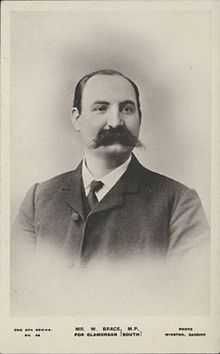South Glamorganshire (UK Parliament constituency)
| South Glamorganshire | |
|---|---|
|
Former County constituency for the House of Commons | |
| 1885–1918 | |
| Number of members | one |
South Glamorganshire was a parliamentary constituency in Glamorganshire, Wales. It returned one Member of Parliament (MP) to the House of Commons of the Parliament of the United Kingdom, elected by the first past the post system.
Overview
The constituency was created by the Redistribution of Seats Act 1885 for the 1885 general election, and abolished for the 1918 general election. Of all the Glamorgan seats created by the 1885 redistribution, South Glamorgan was the only one where the Liberal Party could not be assured of victory. The Bute and Dunraven families exercised a powerful influence. The mining areas of the lower Rhondda and the cosmopolitan town of Barry were strongly Liberal but these were juxtaposed against the conservatism of the Vale of Glamorgan and the gentile settlements of Penarth and Llandaff.[1]
Boundaries
Created in the redistribution of seats in 1885 & from the old Glamorganshire constituency which had been in existence since 1541, the seat covered a wide area that included Bridgend, Porthcawl, Coity, Ewenny, Ogmore, Llanharry, Llanharan, Cowbridge, Llantwit Major, Dinas Powis, Pendoylan, Bonvilston, Barry, Penarth, & some of what is now part of Cardiff which included Whitchurch, Lisvane, Radyr, St Fagans, Llanishen, & Llantrisant, Tonyrefail, Pontyclun, Beddau. It was scrapped in the next redistribution of seats that took place in 1918.
Members of Parliament
| Election | Member | Party | |
|---|---|---|---|
| 1885 | Arthur Williams | Liberal | |
| 1895 | Windham Wyndham-Quin | Conservative | |
| 1906 | William Brace | Liberal | |
| 1918 | constituency abolished | ||
Elections
Elections in the 1880s
At the 1885 election, Arthur Williams succeeded in capturing the seat by a fairly narrow majority of 918. The seat was held in 1886 by the Liberals who obtained a majority 1,320 over the Conservative Unionist Party.[2]
Elections in the 1890s
The seat was held in 1892 by the Liberals who obtained a majority of 918 over the Conservative Unionist Party.[3] In the General Election of 1895 the Conservative Party gained the constituency from the Liberal Party, obtaining an 825 vote majority.[4]
Elections in the 1900s
| General Election 1900: South Glamorgan[5] | |||||
|---|---|---|---|---|---|
| Party | Candidate | Votes | % | ±% | |
| Conservative | Windham Henry Wyndham-Quin | 6,841 | 51.98 | ||
| Liberal | W.H. Morgan | 6,322 | 48.03 | ||
| Majority | 519 | 3.95 | |||
| Turnout | 13,163 | ||||
| Conservative hold | Swing | ||||

| General Election 1906: South Glamorgan[6] | |||||
|---|---|---|---|---|---|
| Party | Candidate | Votes | % | ±% | |
| Liberal | 10,514 | 63.30 | +15.27 | ||
| Conservative | Windham Henry Wyndham-Quin | 6,096 | 36.70 | -15.28 | |
| Majority | 4,418 | 26.60 | |||
| Turnout | 16,610 | ||||
| Liberal gain from Conservative | Swing | +15.28 | |||
- was the official Liberal candidate but often described as Liberal-Labour
Elections in the 1910s
| General Election January 1910: South Glamorgan[7] | |||||
|---|---|---|---|---|---|
| Party | Candidate | Votes | % | ±% | |
| Liberal | 11,612 | 61.05 | -2.25 | ||
| Conservative | Lewis Morgan | 7,411 | 38.96 | +2.26 | |
| Majority | 4,201 | 22.09 | -4.51 | ||
| Turnout | 19,023 | 82.88 | N/A | ||
| Liberal hold | Swing | +2.26 | |||
- some sources incorrectly describe him as the Labour Party candidate.
| General Election December 1910: South Glamorgan[8] | |||||
|---|---|---|---|---|---|
| Party | Candidate | Votes | % | ±% | |
| Liberal | William Brace | 10,190 | 58.43 | -2.62 | |
| Conservative | Lewis Morgan | 7,252 | 41.58 | +2.62 | |
| Majority | 2,938 | 16.85 | -5.24 | ||
| Turnout | 17,442 | 75.99 | -6.89 | ||
| Liberal hold | Swing | +2.62 | |||
See also
- A map of Glamorganshire in 1885, showing its new divisions.
- Boundary Commission Map Report from 1885 showing detailed original maps used
- The National Library for Wales: A Dictionary of Welsh Biography (Windham Henry Wyndham-Quin, 5th Earl Dunraven and Mount-Earl)
- The National Library for Wales: A Dictionary of Welsh Biography (William Brace)
References
- ↑ Morgan. "Democratic Politics". p. 10.
- ↑ The Times House of Commons Guide 1910, 1911, 1919, Poltico's Publishing Page 92 1910 Section
- ↑ The Times House of Commons Guide 1910, 1911, 1919, Poltico's Publishing Page 92 1910 Section
- ↑ The Times House of Commons Guide 1910, 1911, 1919, Poltico's Publishing Page 92 1910 Section
- ↑ The Times House of Commons Guide 1910, 1911, 1919, Poltico's Publishing Page 101 1911 Section
- ↑ The Times House of Commons Guide 1910, 1911, 1919, Poltico's Publishing Page 92 1910 Section
- ↑ The Times House of Commons Guide 1910, 1911, 1919, Poltico's Publishing Page 92 1910 Section
- ↑ The Times House of Commons Guide 1910, 1911, 1919, Poltico's Publishing Page 101 1911 Section
Bibliography
- Morgan, Kenneth O. (1960). "Democratic Politics in Glamorgan, 1884-1914". Morgannwg 4: 5–27.